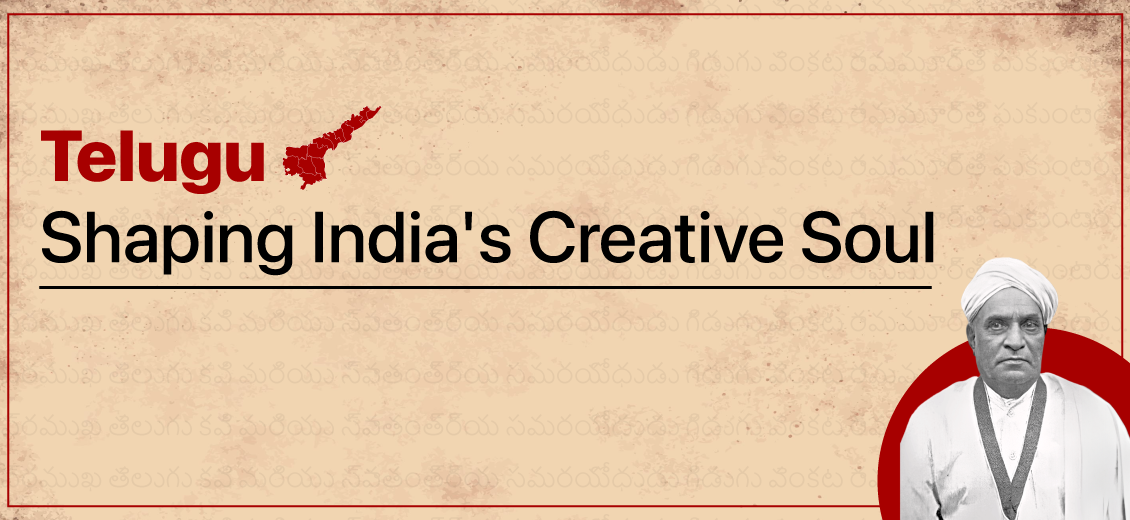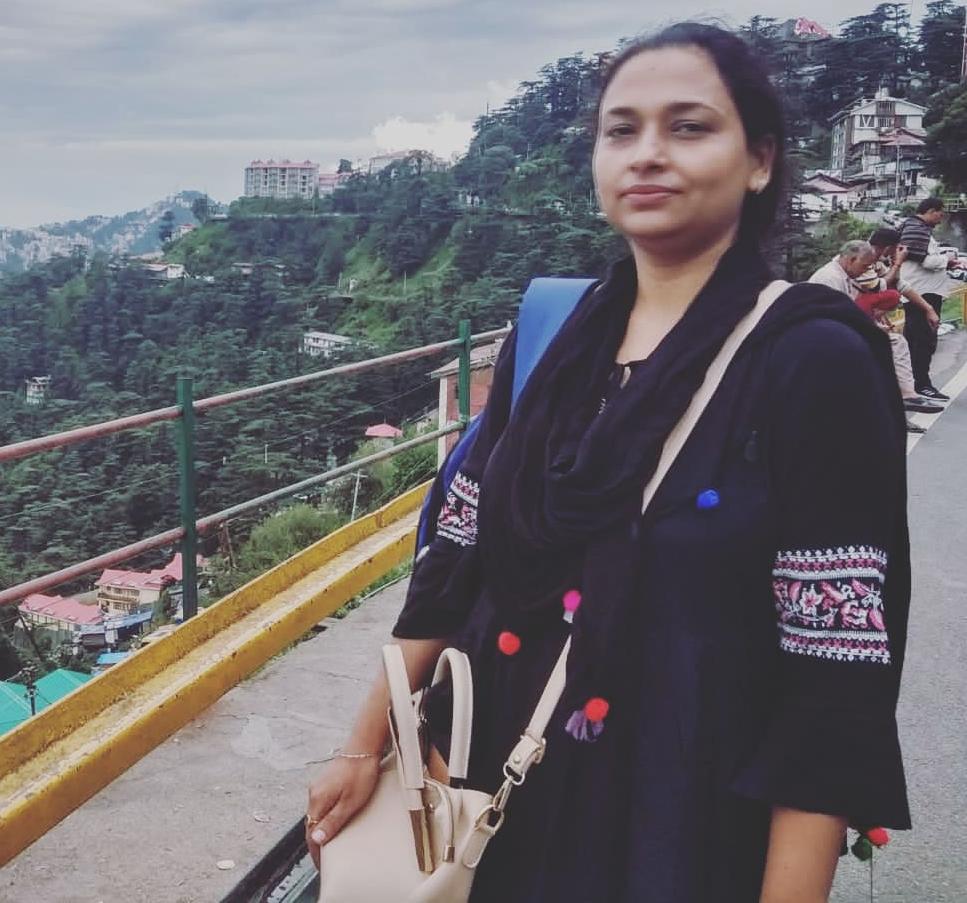Telugu: Shaping India's Creative Soul
Blogs Home
- 29 Aug 2023

Telugu Language Day (తెలుగు భాషా దినోత్సవం; Telugu bhāṣā dinōtsavaṁ) is celebrated annually on August 29 in the states of Andhra Pradesh and Telangana. This date was picked to coincide with the Telugu poet Gidugu Venkata Ramamurthy's birthday. Telugu, one of the major languages of India, has played a crucial role in shaping the country's creative soul. With a rich literary and cultural heritage dating back thousands of years, Telugu has been an integral part of India's artistic and creative landscape. It is the most popular branch of the Dravidian language family. It is the official language of the states of Andhra Pradesh and Telangana and is primarily spoken in south-eastern India. Telugu has around 75 million speakers in the early 21st century.
Telugu as a Global Language
Telugu is one of the world's oldest languages. It is distinct in its origins, and it was the epicentre of political agitation that resulted in the establishment of linguistic states in India. According to a study conducted by an American think-organization. Telugu is the most rapidly expanding language in the United States. It is also a protected language in South Africa. In the previous seven years, the number of people who speak Telugu has increased by 86%. More than 400,000 Telugu speakers lived in the United States in a year, nearly doubling the amount in 2010. Seven of America's top ten fastest-growing languages are from South Asia. It, however, remains outside the top 20 most widely spoken languages other than English.
Telugu and Indian Identity
Telugu people have a distinct cultural identity that contributes to the broader Indian identity. They have a unique literary tradition dating back to ancient times, with a vast collection of classical literature and poetry. The classical language of Telugu has had a profound impact on Indian literature, arts, and philosophy. At the same time, Telugu people are an integral part of the diverse Indian population, which includes people from different linguistic, religious, and regional backgrounds. India's national identity emphasizes unity in diversity, recognizing and celebrating the multitude of cultures and traditions that coexist within its borders.
The Government of India has identified Telugu as one of six classical languages. Telugu is the 4th most spoken language in India. It is the world's 14th most-spoken native language. Modern Standard Telugu has its roots in the vernacular of Coastal Andhra's Krishna-Godavari delta region.
Telugu Classical Literature
Telugu has a vibrant literary tradition that dates back to ancient times. It has produced a vast body of literature, including poetry, epics, dramas, and philosophical works. Telugu literature is evidenced to contain various forms of writing in any genre of verse, novel, or play, as can be stated - Prabandham, Kavyam, containing within itself the Padya kavyam, Gadya kavyam and Kanda Kavyam (short poems), Kavitha, Avadhanam, Navala, Katha, and Natakam (Anthology).
The language's first written documents date from 575 CE. The Telugu script is based on the Chalukya dynasty's script from the 6th century and is related to the Kannada language. The famous Telugu poet Nannayya is credited with initiating the translation of the great Indian epic, the Mahabharata, into Telugu. This marked the beginning of Telugu as a literary language.
The golden period of Telugu literature flourished between the 16th and 17th centuries when Sri Krishnadevaraya became interested in Telugu literature. Other than Sri Krishna Devaraya's Amukthamalyada, Manucharitra by Peddana is an exceptional Mahakavya.
Kandukuri Viresalingam Pantulu was the father of modern Telugu literature. He wrote a novel called Rajasekhara Charitamu in response to the Vicar of Wakefield. He was the first and greatest modern-day author to utilize literature to combat social injustices and beliefs. Other prominent Telugu writers who came after him included Rayaprolu Subba Rao, Gurazada Appa Rao, Viswanatha Satyanarayana, Jashuva, Devulapalli Krishna Sastry, Sri Sri, Puttaparty Narayana Charyulu, and many others.
Telugu Language and Linguistic Heritage
Telugu has a strong linguistic heritage, and its preservation and promotion remain crucial to maintaining the cultural diversity and linguistic richness of India. The Government of India declared Telugu a classical language in 2008, recognizing its historical significance, rich literature, and contribution to Indian culture. It is one of the 22 scheduled languages of India and has a rich linguistic heritage. Telugu has several regional dialects, each with its unique linguistic features. The major dialects include Rayalaseema, Coastal Andhra, Telangana, and Vadari. The Telugu script is a syllabic alphabet that has undergone several changes over the centuries. The current script, known as the Telugu script, evolved from the ancient Brahmi script and is written from left to right. Telugu has been influenced by various languages and cultures over time. It has borrowed words from Sanskrit, Persian, Arabic, Turkish, English, and other languages due to historical interactions with different regions and empires.
Telugu Folk Literature and Performing Arts
Telugu folk literature and performing arts have a rich and diverse tradition that reflects the culture, history, and social life of the Telugu-speaking people. These art forms have been passed down through generations, carrying the essence of the region's heritage. Here are some key aspects of Telugu folk literature and performing arts:
Janapada Sahityam: It refers to the traditional folk literature of Telugu-speaking regions. Janapada Sahityam includes various forms of oral literature such as folk songs, ballads, proverbs, and stories.
Burrakatha: It is a traditional storytelling art form that combines narrative, music, and dance. Burrakatha often narrates historical and mythological stories, emphasizing moral values and social issues.
Oggu Katha: It is a unique traditional art form performed in the Telangana region. Oggu Katha involves storytelling with lively music and dance. The narratives often revolve around the heroic deeds of deities or historical figures, and it is accompanied by the beat of drums called "Oggu."
Kuchipudi: It is a classical dance form that originated in the village of Kuchipudi in Andhra Pradesh. It is characterized by its fast footwork, dramatic expressions, and intricate hand gestures. Kuchipudi often combines elements of storytelling, music, and dance to portray mythological tales and devotional themes.
Harikatha: Harikatha is a devotional storytelling performance that combines storytelling, music, and religious discourse. The performer, called the Harikatha artist, narrates and sings stories based on Hindu mythology, emphasizing moral and spiritual teachings.
Folk Dances: Telugu-speaking regions have a variety of folk dances representing their cultural diversity. Some popular folk dances include Dhimsa, Lambadi, Bonalu, and Kolatam, each having its unique style and significance.
Telugu Culture and Heritage
Telugu culture and heritage refer to the rich and diverse cultural traditions, customs, and history of the Telugu-speaking people. Telugu culture has deep roots, dating back centuries, and is characterized by its unique art forms, literature, dance, music, festivals, cuisine, and lifestyle. Telugu people celebrate a myriad of festivals throughout the year. Some of the most popular ones include:
- Ugadi: The Telugu New Year, celebrated with great enthusiasm, marks the beginning of a new lunar calendar.
- Sankranti: Celebrated in mid-January, it is a harvest festival associated with flying kites, traditional dishes, and bonfires.
- Dasara: The ten-day Navaratri festival culminates with Vijayadashami, symbolizing the triumph of good over evil.
- Diwali: The festival of lights is celebrated with the lighting of lamps and sharing sweets.
Telugu in Contemporary Times
Telugu language and literature have significant roles in modern education and media, fostering cultural identity, language development, and regional representation. They continue to shape the way people communicate, learn, and interact in the contemporary world. Telugu language newspapers, magazines, and journals have a wide readership in Andhra Pradesh and Telangana. The widespread use of Telugu in electronic media further strengthens its presence in modern society. With the growth of the internet and digital platforms, Telugu language content is gaining traction online. Websites, blogs, and social media platforms in Telugu cater to diverse interests, ranging from news and education to entertainment and lifestyle.
Preserving and promoting Telugu, like any other regional language, faces several challenges in the digital age. With the dominance of English in the digital world, many Telugu speakers prefer to use English for communication, content consumption, and online interactions. This trend leads to a decline in the use and popularity of Telugu in digital spaces. Many Telugu speakers, particularly older generations, might not be familiar with digital technology and its usage. There is a need to promote digital literacy and create awareness about the benefits of using Telugu in the digital space. Social media platforms play a significant role in shaping language trends. While they offer an opportunity to promote Telugu, they can also lead to the adoption of colloquial language and shortcuts, potentially leading to the erosion of proper grammar and vocabulary.
Conclusion
Undoubtedly, Telugu has been instrumental in shaping India's creative soul, with its rich literary heritage, artistic expressions, and significant contributions to cinema and other art forms. The language and culture of Telugu continue to thrive, inspiring creativity and enriching the diverse tapestry of Indian creativity. Promoting digital literacy, creating high-quality content, developing user-friendly digital tools, and raising awareness about the importance of preserving Telugu heritage are some of the steps that can be taken to ensure the growth of Telugu in the digital age.
Sources
- https://www.drishtiias.com/daily-news-analysis/classical-languages
- https://www.britannica.com/topic/Telugu-language
- https://academic-accelerator.com/encyclopedia/telugu-language
- https://academic-accelerator.com/encyclopedia/telugu-literature
- https://www.indianetzone.com/2/telugu_literature.htm
- https://www.bbc.com/news/world-45902204
Arifa Nadeem

Arifa Nadeem is from Jhansi, UP. She has qualified for UGC NET in Tourism Administration & Management and is currently pursuing her Ph.D. in Tourism from Bundelkhand University, Jhansi.
Blogs Home



